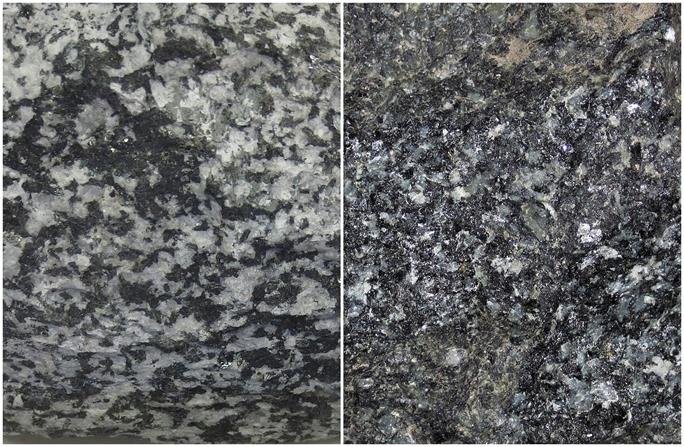Both diorite and gabbro are coarse-grained rocks. They both form from the slow cooling of magma. This slow cooling allows large crystals to grow.
However, their mineral and composition varies. Dorite is an intermediate rock, and gabbro is a mafic rock. Mafic rocks are rich in iron and magnesium but low in silica and alkali oxides.
On the other hand, intermediates are mesocratic or moderate in silica, iron, and lighter elements like sodium and potassium.
Let us look at the differences between these two rocks in detail.

Physical appearance and properties
The first way to differentiate diorite from gabbro is by considering their physical properties.
Diorite is lighter in color, usually gray to dark gray, and less dense. In contrast, gabbros are darker, usually dark gray, dark green to black, and denser.
Considering their color index M’, diorite has a color index less than 35, while gabbro has more than 35-90. This means you will see more darker minerals on gabbro than on diorite.
The color index is the percentage ratio of darker or mafic minerals. It is defined as 100 less felsic minerals, muscovite, apatite, and primary carbonate.
Lastly, gabbro is denser than diorite due to the higher proportion of denser elements like calcium, iron, and magnesium.
Chemical composition
Chemically, diorite is an intermediate rock with 52-63 wt.% silica. It is also moderate in iron, magnesium, potassium, and sodium oxides.
In contrast, gabbro is a basic rock with 45-52 wt.%. This rock is high in iron, calcium, and magnesium oxide and relatively low in alkali oxides (sodium and potassium oxides.
Bottom line
Diorite is higher in silica and alkali oxides than gabbro, while gabbro is lower in silica and higher in iron, calcium, and magnesium oxides.
Mineral composition
Considering their mineralogy, diorite has sodium-rich, calcium-poor plagioclase, biotite, hornblende, and small amounts of pyroxene (augite and orthopyroxene.
The plagioclase is mainly plagioclase has less than 50 mol.% anorthite and is usually andesine and less often oligoclase.
On the other hand, gabbro has calcium-rich plagioclase, augite, and smaller amounts of olivine, orthopyroxene, hornblende, and rarely biotite.
The plagioclase present has more than 50 mol.% anorthite and ranges from labradorite to bytownite.
Both rocks can have a small amount of quartz, alkali feldspar, and accessory minerals.
Bottom line
In gabbro, plagioclase is sodium-rich and calcium-poor with <50 mol.% anorthites and is usually andesine or oligoclase with main mafic minerals biotite and hornblende with pyroxene a small amount.
On the other hand, gabbro has calcic plagioclase with >50 mol.% anorthite, usually labradorite to bytownite, while augite is the main mafic mineral with a minor amount of hornblende and rarely biotite.
Also, biotite and hornblende are the dominant mafic minerals in diorite, while gabbro mostly has augite and rarely has biotite.
Formation
Diorite is a plutonic rock formed deep inside the Earth’s crust. In contrast, gabbro is mostly plutonic, with some extrusive elements formed in the interior parts of thick basalt lava flows.
Where diorite and gabbro occur
Diorite occurs in the continental crust and is a minor component of intrusions above subduction zones.
On the other hand, gabbro dominates the oceanic crust beneath sheeted dikes and occurs in layered intrusion but as a minor component.
